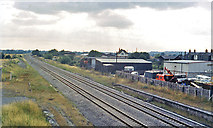Nice to hear Challow and Uffington being mentioned. As a fireman at Didcot we worked the daily "Swindon Fly", which shunted at most of the local stations too and from Swindon. Which stations were served alternated daily according to the consignments. Some days the run was quite short but you could run into overtime when having to shunt virtually all remaining goods sidings there and back.
We always went onto Swindon Depot to service the loco and have booked break. The Depot was always full of locomotives of all types and sizes. It was still mostly steam but there were Westerns, Hymacks and 800's also.
I always found it interesting to view Wantage Tramway No. 5 "Shannon" standing on it's plinth at Wantage Road and at that time there was still a lot remaining of the Tramway Terminus at Wantage Road.
Steventon, Challow, Uffington and Shrivenham all in situe with btheir platform buildings and the goods sidings looked as if they were just waiting for the next goods train to arrive. The island platform at Uffington was also still complete and the Farrindon track still ran towards that terminal, with the Up distant signal that remained in place for many years after the branch closed. For a short time after I started there, even Stratton St Margaret station was still in place and of course the branch to Highworth was still used as far as Stratton for goods and I believe too most of the track as far as Highworth, though unused.
Steventon was always interesting due to having been the headquarters of the GWR in the early year with it's interestingly designed building for that purpose.
The local passenger trains ran into the Down Bay platform at Didcot and you never knew what type of loco would be hauling the one or two-coach train as the most poweful of locos were seen as the train was used for running-in locos after servicing at Swindon.
Adrian Vaughn was known to most train crew, though this was prior to him becoming more known through his railway books. One incident I remember was around 1967, having a number of dead locomotives on the train that were going for scrap. The train loco was a Hall engine. We ran up to Challow on a warning and there was Adrian at the signalbox window with the steady red flag. Before the wheels had actually stopped Adrian was out of the box and running back along the train and climbed onto one of the loco's. A Pannier Tank, if I recall correctly and he was soon back struggling with a couple of 'whatever' metal lumps, back up into the box, signals cleared, a green flag and off we set. Not a word spoken by either of us. I still wonder what interesting part(s) he had got off that loco! The driver had a good laugh at that one and it became the talking point during our break at the new Swindon Depot cabin nearer the station, which had recently been built at that time.
We also worked the coal trains from day one at Didcot Power Station. Most coal came from the north in those days and worked mostly by Saltley crew, with Bescot crew at times. I remember a Sheffield crew getting through at one time and wondered how they had worked that out for time. It could take 12 hours too and from Saltley at times.
Didcot crew at that time just unloaded the trains while the coal train crews had their breaks. A Mess room was built on the west curve at Foxhall for this purpose.
Although we just worked the power station side of the job the trains were so regular that you could do 12 hours easily working train after train. Ech took abut 50 minutes to compete but there were the usual delays from broken wagon axels, couplings or brake pipe connection, signal and point failures and even the automatic hopper plant would suffer failures. When trains followed too closely you would often start the next train but find the underground conveyand hoppers would fill up and have to wait for them to clear enough coal to continue dropping more.
Even if getting clear through you could fine that the previous coal train was still standing at the control signal atthe plant exit waiting for passenger trains clearing the station and north junction in the peak hours. And so delays would build up that way.
The northern coal trains lasted until they built the Coal Concentration Depot at Avonmouth and the loops between Challow and Didcot were built to handle this traffic that ran round the clock. Prior to this the Up & Down Loops were at Uffington.
Didcot Power station 'A' is now officially closed. As far as I'm aware nothing goes in there anymore but of course, it could be that an occassional train may still go there for clearing work of some sort. Possibly too they will use trains for clearance work when the plant is demolished. These coal trains became our bread & butter jobs at Didcot and definitely saved the depot from closure after steam went. Most of use were sure close would happen soon after the end of steam. The power station saved the day.
Likewise, we thought that Didcot depot would close if the coal went but thankfully the depot continues to thrive, if on a smaller scale as previously. One of my last jobs before retiement was around the power station.


